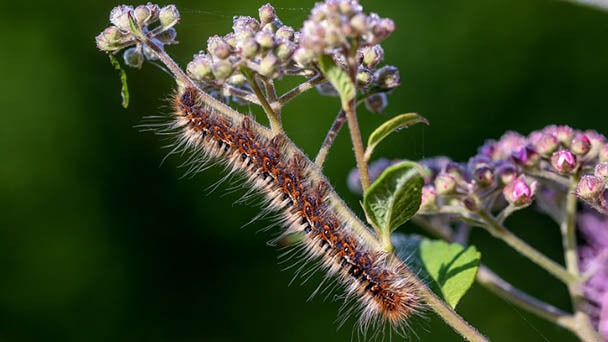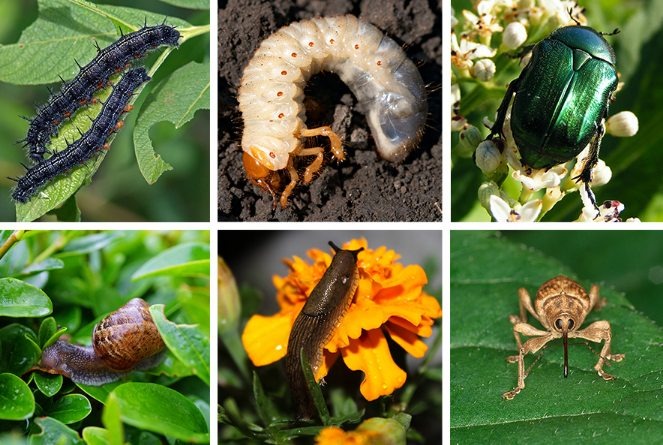Garden Pests & Animals That Eat Flower Petals
Written by Ivy
Dec 27 2022

Although we only think of flowers as decorations, many different animal species actually eat flowers. Due to the potent scent, some of them are even drawn to flowers, where they eat the petals and roots afterward.
Take a look at what animals eat flowers below:
- Snails
- Turtles
- Squirrels
- Lizards
- Opossums
- Deer
- Moose
- Rabbits
- Insects
There are other animals that exist besides the traditional insect pollinators that consume flowers. While the majority of these animals are dependent on flowers to survive, their methods for obtaining them have put them on gardeners' "pest" lists.
1. Snails
Snails are tinier creatures that consume flowers but also use them as cover during the day. They venture outside at night to feed, and in sunny, moist areas, they typically eat flowers.
They favor lilies and irises but also adore orchids and pose a threat to anyone with orchids. In your garden, snails will quickly multiply into a large population and devour your orchids until they are gone.
2. Turtles
For the record, most herbivores will consume flowers if they are starving. But for some, eating flowers is just a normal part of life. The order of species that includes turtles regularly consumes plants, including flowers.
They mostly eat plants and flowers, though they are capable of eating meat if the opportunity arises. Because of their slow speed and propensity to stay close to wet areas like lakes and rivers, turtles are unlikely to invade gardens, even though they won't run away from a flower if they are hungry.
3. Squirrels
Given their inability to process cellulose, squirrels try to avoid eating plants as much as possible, but if they are starving and there is nothing else to eat, they will consume flowers. This is extremely uncommon, though, as eating a flower can have negative effects on them.
When they run out of nuts, they are also known to eat tree buds. Some squirrels have also been observed consuming meat, whether it came from an animal they found or one they killed.
This is also extremely uncommon, though, as squirrels have trouble processing all foods other than nuts.
4. Lizards
Only 2% of lizards eat plants, with the iguana being the most well-known. These reptiles enjoy eating flowers and will consume the petals, stem, and leaves.
It has also been shown that some non-plant-eating species of lizards force themselves to consume fruit despite the fact that it is not in their natural diet simply because it is so simple to find and digest.
Reptiles can break down bones, hooves, and horns thanks to their powerful stomach acids. However, young lizards that consume plants have trouble processing the plants, so they consume the feces of adults to get the microflora they need.
5. Opossums
In North and Central America, there are more than 120 different species of opossum, and quite a few of them love flowers in addition to being willing to eat them.
Because of the flowers' overpowering scent, opossums are frequently drawn to them, but they eat the entire plant because of the nectar. They pose a significant threat to flower growers because, given the chance, they will devour an entire garden.
They are interestingly resistant to a wide range of things. Some opossum species have enhanced immunity to flowers, so they won't give them food poisoning. They are also immune to rattlesnake venom.
6. Deer
There aren't many plants that deer won't eat, and they adore flowers in particular. They won't eat a cactus (for obvious reasons) and irises because they don't taste good, to name a few.
Aside from those types of flowers, deer will eat practically anything, and they even like it. They frequently run into human beings here. Deer are very strong animals, so they can easily jump over fences to access a flower garden.
They frequently risk their lives to obtain flowers because they are so hungry. Installing a very tall fence is the only way to defend against them, and this usually takes care of the issue.
Deer will eat any flower fields they come across in the wild.
7. Moose
This gentle giant is more than happy to eat flowers because it requires incredible amounts of food to survive on a daily basis. Typically, this occurs in the winter, a time of food scarcity.
In Alaska, Canada, Scandinavia, and Russia, there are numerous flower species that can grow and even bloom in the dead of winter; this is the kind of food that moose will seek out.
Since there isn't much else for them to eat at that time, a significant portion of their diet actually consists of flowers. Not just flowers that are blooming from the ground, they also consume flowers that are growing on trees.
8. Rabbits
Like deer, rabbits are a problem when it comes to flowering plants. Both in the wild and in captivity, they'll eat just about any flower, which can be problematic for gardeners.
They typically invade gardens close to woodlands because they prefer eating lower-growing flowers due to their short stature. In comparison to deer, they're also harder to defend against!
Because rabbits are so tiny, it is challenging to erect a fence that will keep them out (because the mesh needs to be more dense). Rabbits are burrowers and extremely agile, so they will still manage to get through a fence. There's a chance they'll squeeze through like a cat would.
9. Insects

Insect species number in the hundreds of thousands worldwide, but many of them eat flowers. For instance, male mosquitoes feed on the nectar found inside the flowers (while the females sucking blood), and crickets and grasshoppers will gladly take a bite from a petal.
Japanese beetles are an invasive species that has spread throughout the United States and depend solely on flowers for food. The fact that many insects consume flowers while also being essential to the survival of the entire planet must be kept in mind.
The majority of pollinators on Earth are insects, and they are essentially maintaining some stability in the entire ecological system.
Bees
We probably don't have to tell you that bees are practically synonymous with the term "insect pollination". Still, without these diligent insects, a list of animals that pollinate plants would be incomplete.
There are at least 250 species of this common bug buzzing around the world, despite the fact that we typically only think of bumblebees and honeybees. Without a doubt, plant reproduction wouldn't be the same without the bees, even though some of those species are more beneficial to the environment than others and some are more beneficial to people.
Ladybugs
Also called "ladybirds" and "lady beetles," ladybugs don't so much eat or pollinate flowers as much as protect them, earning them yet another title: gardener's best friend.
These recognizable garden-party bugs fight harmful pests for the rest of their lives. They are drawn to plants like dill, fennel, and the low-maintenance yarrow. Ladybugs enjoy munching on aphids, mites, and mealybugs as both larvae and adults, and they do it with all the poise and dignity of a real lady, if we do say so ourselves.
Caterpillars
It's not a coincidence that you've likely noticed a fair number of caterpillars lounging on flower stems. Caterpillars don't just eat the nutrients provided by a variety of plants and flowers, such as parsley, willow, violet, aster, and daisies; they also ensure that their larvae won't have to travel far for food by laying their eggs right on the flowers. Room service, anyone?
Moths & Butterflies
It should come as no surprise that butterflies and moths also enjoy flowers since caterpillars are known to be flower-lovers. While there are thousands of species of moths, butterflies are much less common, which may be part of what makes them so attractive. In fact, it has become a tradition in Great Britain to go outside and count all the butterflies you can find. It seems very tranquil to us!
Maintain the violet, lavender, and sunflower plants because moths and butterflies are particularly attracted to purple and yellow flowers.
Hummingbirds
You must have anticipated this. Perhaps the most well-known pollinators after bees, hummingbirds are also our strongest contenders for the top spot in the popularity stakes for flower lovers. Hummingbirds are known to have an intense love for flowers—or more specifically, the nectar found in flowers—to the point where they will reportedly exert more effort to reach the sweetest flowers, which often hang upside-down.
What flowers do hummingbirds prefer, then? Consider planting lots of bee balm, butterfly bush, or lilies if you want to see more of these tiny creatures hovering around your garden. The bees and butterflies will appreciate it too, as their names imply!
Hedgehogs
Imagine a hedgehog. Now imagine a hedgehog donning a miniature sun hat and the world's tiniest gardening gloves – because, as if hedgehogs weren't already cute enough, they're also another (adorable) "gardener's friend".
They thankfully won't destroy our flowers. Instead, they use them as a place to hide while munching on the crawling beetles and caterpillars. (Sorry, caterpillars!)
Lizards
Yes, it's now known that lizards carry pollen on their tiny lizard feet, assisting the reproduction of our favorite flowers. Scientists were also surprised! But now that you are aware of the crucial function lizards play in the pollination of plants, you should (hopefully) feel a little less repulsed the next time you see a tiny dinosaur slithering away from your favorite rosebush.
Summary
The majority of flower-eating animals on the planet are probably insects, but they are by no means the only ones. In addition to being a secondary food source, many other animals, the majority of which are regarded as pests, will eat flowers.
Deer and rabbits are two common pests that flower growers struggle with. Turtles and lizards are examples of animals that consume flowers in the wild, and there are likely other species that will consume flowers in a pinch but have not yet been identified.
FAQs
What Animal is Eating My Flowers at Night
Your pest might not be an insect because many animals come out at night to eat in the privacy of the shadows. Some common nighttime feeders are deer, groundhogs, rabbits, raccoons, opossums, and skunks. The most destructive animals are usually deer and rabbits.
Do Birds Eat Flowers
Why do birds eat flower and bud buds? The answer is simple – They are nutritious. Actually, according to some experts, flowers are more valuable as food than buds. Birds that consume these tasty foods have an advantage over those that do not.
Latest Updated
- Benefits of Bugleweed - 7 Science-backed Health Benefits
- Bugleweed Dangers & Side Effects - Is It Poisonous?
- How to Plant Evergreen Trees - What You Should Know
- When to Plant Evergreens - Grow Guide for Evergreen Trees
- 12 Wonderful Evergreen Shrubs for Your Garden
- 12 Popular Evergreen Plants with Pictures for Beginners
- When And How To Prune A Lilac Bush Like a Pro
- How to Grow & Care for Lilac Vine (Hardenbergia Violacea)
- Japanese Lilac Tree (Syringa Reticulata) Care & Propagation Guide
- Shumard Oak Pros and Cons - What to Know
Popular Articles
- Winter maintenance of Antirrhinum Majus
- How to Grow Terminalia Mantaly Tree
- How to Grow and Care for Crossostephium Chinense
- How to grow Antirrhinum Majus in spring
- Peristeria Elata (Dove Orchid) Profile: Info & Care Guide
- Underwatered Snake Plant (Sansevieria Trifasciata) - Signs And How To Fix
- How to Care for Brazilian Jasmine Plant (Mandevilla Sanderi)
- How to Grow & Care for Graptopetalum Purple Delight in Summer
- Rosa Chinensis (China Rose): Plant Growing & Care Tips
- How to Care for Baby Sun Rose (Aptenia Cordifolia)